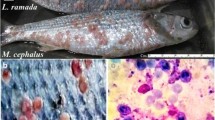Abstract
Striped red mullet is a commercial valuable species for fisheries. Due to its economic importance, captivity studies were carried out to check the suitability of this species to culture conditions. In order to improve it, a wild-caught broodstock was created and kept in captivity for 4 years. Mullets were very susceptible to handling stress resulting in a high mortality during capture and quarantine stage (45.8%). Once they moved to long-term facilities, they showed good food acceptance and gregarious behaviour, but mortality never disappear. Total survival was 15.86%. Some fish were asymptomatic, but most of them had an extreme weight loss with severe emaciation and cachexia. The histopathological study showed presence of Myxozoa Ceratomyxa sp. parasite in most of the dead fish (>70%). Ceratomyxa sp. was detected in gallbladder, intestine and kidney. The presence of trematodes, nematodes and annelids was occasional, showing lower parasite diversity and prevalence than in natural conditions. This might be due to the pathogen-free diet that can cause a host-parasite imbalance by inducing other parasitic infections. In addition, culture conditions might reduce the immune response and favour ceratomyxosis due to the easily stressed nature of striped red mullet.


Similar content being viewed by others
References
Alama-Bermejo G, Raga JA, Holzer AS (2011) Host-parasite relationship of Ceratomyxa puntazzi n. sp. (Myxozoa: Myxosporea) and sharpsnout seabream Diplodus puntazzo (Walbaum, 1792) from the Mediterranean with first data on ceratomyxid host specificity in sparids. Vet Parasitol 182:181–192. doi:10.1016/j.vetpar.2011.05.012
Alvarez-Pellitero P, Sitjà-Bobadilla A (1993) Ceratomyxa spp. (Protozoa: Myxosporea) infections in wild and cultured sea bass, Dicentrarchus labrax, from the Spanish Mediterranean area. J Fish Biol 42:889–901. doi:10.1111/j.1095-8649.1993.tb00398.x
Angot V, Brasseur P (1993) European farmed Atlantic salmon (Salmo salar L.) are safe from anisakid larvae. Aquaculture 118:339–344. doi:10.1016/0044-8486(93)90468-E
Bartholomew JL (1998) Host resistance to infection by the myxosporean parasite Ceratomyxa shasta: a review. J Aquat Anim Health 10:112–120. doi:10.1577/1548-8667(1998)010<0112:HRTIBT>2.0.CO;2
Bautista-Vega AA, Letourneur Y, Harmelin-Vivien M, Salen-Picard C (2008) Difference in diet and size-related trophic level in two sympatric fish species, the red mullets Mullus barbatus and Mullus surmuletus, in the Gulf of Lions (north-west Mediterranean Sea). J Fish Biol 73:2402–2420. doi:10.1111/j.1095-8649.2008.02093.x
Devauchelle N (1980) Etude expérimentale sur la reproduction, les ouefs et les larves de: bar, daurade, mullet, rouget, sole, turbot. These L’ Universite de Bretagne Occidentale
Devauchelle N (1983) Reproduction en captivité du rouget (Mullus surmuletus). In: ICES, F/17, Comité Mariculture. p 5
Díez DM (2013) OIsurv: survival analysis supplement to Open Intro guide. Open intro.org
Feist SW, Longshaw M (2008) Histopathology of fish parasite infections—importance for populations. J Fish Biol 73:2143–2160. doi:10.1111/j.1095-8649.2008.02060.x
Félix-Hackradt FC, Hackradt CW, Pérez-Ruzafa Á, García-Charton JA (2013) Discordant patterns of genetic connectivity between two sympatric species, Mullus barbatus (Linnaeus, 1758) and Mullus surmuletus (Linnaeus, 1758), in south-western Mediterranean Sea. Mar Environ Res 92:23–34. doi:10.1016/j.marenvres.2013.08.008
Ferrer-Castelló E, Raga JA, Aznar FJ (2007) Parasites as fish population tags and pseudoreplication problems: the case of striped red mullet Mullus surmuletus in the Spanish Mediterranean. J Helminthol 81:169–178. doi:10.1017/S0022149X07729553
Gunter NL, Whipps CM, Adlard RD (2009) Ceratomyxa (Myxozoa: Bivalvulida): robust taxon or genus of convenience? Int J Parasitol 39:1395–1405. doi:10.1016/j.ijpara.2009.04.008
Hassani MM, Kerfouf A, Boutiba Z (2014) Checklist of helminth parasites of striped red Mullet, Mullus surmuletus (Linnaeus, 1758) (Perciformes: Mullidae), caught in the Bay of Kristel , Algeria (western Mediterranean). Check List 11:1504. doi:10.15560/11.1.1504
Izquierdo MS, Fernández-Palacios H, Tacon AGJ (2001) Effect of broodstock nutrition on reproductive performance of fish. Aquaculture 197:25–42. doi:10.1016/S0044-8486(01)00581-6
Kent ML, Andree KB, Bartholomew JL et al (2001) Recent advances in our knowledge of the Myxozoa. J Eukaryot Microbiol 48:395–413
Klimpel S, Kleinertz S, Palm W (2008) Distribution of parasites from red mullets (Mullus surmuletus L., Mullidae) in the North Sea and Mediterranan Sea. Bulletin Of Fish Biology 10:1–14
Labropoulou M, Machias A, Tsimenides N, Eleftheriou A (1997) Feeding habits and ontogenetic diet shift of the striped red mullet, Mullus surmuletus Linnaeus, 1758. Fish Res 31:257–267
Lima dos Santos CAM, Howgate P (2011) Fishborne zoonotic parasites and aquaculture: A review. Aquaculture 318:253–261. doi:10.1016/j.aquaculture.2011.05.046
Mahé K, Coppin F, Vaz S, Carpentier A (2013) Striped red mullet (Mullus surmuletus, Linnaeus, 1758) in the eastern English Channel and southern North Sea: growth and reproductive biology. J Appl Ichthyol 29:1067–1072. doi:10.1111/jai.12266
Marcogliese DJ (2002) Food webs and the transmission of parasites to marine fish. Parasitology 124:83–99. doi:10.1017/S003118200200149X
Mazzola BA, Lopiano L, La Rosa T, Sarà G (1999) Diel feeding habits of juveniles of Mullus surmuletus (Linneo 1758) in the lagoon of the Stagnone di Marsala (Western Sicily, Italy). J Appl Ichthyol 15:143–148. doi:10.1046/j.1439-0426.1999.00135.x
Menu B, Girin M (1979) Ponte, incubation et développment larvaire du rouget de roche (Mullus surmuletus) en laboratoire. Vie Milieu Ab Biol. Mar Oceanogr 28(3):517–530
Migaud H, Bell G, Cabrita E et al (2013) Gamete quality and broodstock management in temperate fish. Rev Aquacult 5:S194–S223. doi:10.1111/raq.12025
N’Da K, Déniel C (1993) Sexual cycle and seasonal changes in the ovary of the red mullet, Mullus surmuletus, from the southern coast of Brittany. J Fish Biol 43:229–244. doi:10.1111/j.1095-8649.1993.tb00425.x
Pajuelo JG, Lorenzo JM, Ramos AG, Méndez-Villamil M (1997) Biology of the red mullet Mullus surmuletus (Mullidae) off the Canary Islands, Central-East Atlantic. S Afr J Mar Sci 18:265–272. doi:10.2989/025776197784160956
R Core Team (2015) R: A language and environment for statistical computing. R Foundation for Statistical Computing, Vienna. Consultado en http://www.r-project.org/
Reñones O, Massutí E, Morales-Nin B (1995) Life history of the red mullet Mullus surmuletus from the bottom-trawl fishery off the Island of Majorca (north-west Mediterranean). Mar Biol 123:411–419. doi:10.1007/BF00349219
Acknowledgements
This work was funded by Xunta de Galicia (Government of Spain) through the project ‘Potential of striped red mullet aquaculture in Galicia’ (PGIDIT02RMA05E).
Author information
Authors and Affiliations
Corresponding author
Rights and permissions
About this article
Cite this article
Barreiro, L., Caamaño, R., Cabaleiro, S. et al. Ceratomyxosis infection in cultured striped red mullet (Mullus surmuletus Linnaeus 1786) broodstock. Aquacult Int 25, 2027–2034 (2017). https://doi.org/10.1007/s10499-017-0166-6
Received:
Accepted:
Published:
Issue Date:
DOI: https://doi.org/10.1007/s10499-017-0166-6




